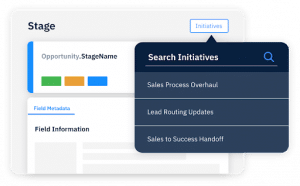According to Salesforce, about 70 percent of all CRM data goes bad. Many Salesforce orgs are cluttered with “dirty data” that comes in the forms of redundancy, obsolete information, inconsistencies and information that is just plain wrong.
We don’t have to tell you how important data is to your organization… but we can say that too much of it within your Salesforce org can confuse your GTM teams on where they should be looking to run the business. This leads to poor organization, wasted time, hindered customer service and more.
This is where a regular Salesforce cleanup is critical. But where do your admins even get started? Read on as we provide you 5 tips to guide your future Salesforce cleanup projects.
Why you need a Salesforce data cleanup
As you begin looking at your data, you might be wondering – what is involved in a Salesforce data cleanup? At its heart, it involves the process of removing and repairing outdated, duplicate, or incorrect information from your Salesforce database. A cleanup is important, as bad data can affect an organization’s revenue by over $9 million a year. On the other hand, having good data can be beneficial in several ways:
1. Enhanced leadership decision making
When you have correct data within your Salesforce org, this empowers an organization’s leadership team to make smarter, better decisions that will move the revenue engine forward. Your RevOps leaders are able to focus their energy on business-critical tasks, knowing they have full confidence in the data being analyzed. And that confidence is key, as research from CIO Dive found that over half of all businesses that make decisions based on data are more likely to reach their revenue goals.
2. Your workforce will be more productive
Your go-to-market team will only be as efficient as the data they’re given. Studies have shown sales professionals waste 30% of their time sorting through bad data, so you can cut back on that time with a good Salesforce cleanup. With proper insight into clients, prospects, and accounts, workplace productivity rises as your go-to-market team can do their jobs effectively. This boost in productivity also helps your Salesforce admin, as they no longer spend all their time fixing bad data – a daunting task in itself.
3. Minimize tech debt
Technical debt is something that is inevitable when it comes to your software, but you can minimize the amount your organization has to deal with by proactively completing Salesforce cleanups. Tech debt is something that happens over time, so avoiding this buildup of bad data is a big factor in your go-to-market team’s success. Staying up-to-date on your Salesforce data is a major way to essentially “repay” that tech debt within your organization.
4. Enhance customer experience
No matter the industry, satisfaction is crucial to your business. And a big part of that satisfaction comes from having the right data on your customers and prospects. Your go-to-market team can do a much better job in gearing their messaging and driving a positive customer experience when they have all the relevant information at hand. And this is important, as almost 90 percent of customers are influenced by personalized content from any given brand messaging.
5 Types of Bad Salesforce Data to Look Out For
In order for your Salesforce cleanup to be successful, you’ll first have to identify what types of bad data you have throughout your Salesforce org.
For most organizations, there will be five types of bad data to look out for – duplicates, inaccurate, irrelevant, inconsistent, and incomplete. So let’s take a dive into each of these to better understand how they impact your Salesforce org.
1. Inaccurate data
You always want your data to be correct when it’s being added into Salesforce. We’re all human however, so sometimes mistakes can happen. In fact, Delpha.io has found that a third of bad data comes from human error. These types of inaccurate data can include:
- Typos or bad grammar: Spelling or grammatical errors can make your messaging seem unprofessional and really turn off a prospect from your company.
- Wrong email address: Being able to communicate with a prospect is important, with email playing a big part in your day-to-today interactions with people. Having the wrong email leads to bounce backs and un-received messaging.
- Incorrect names for individuals or companies: This one is super important, as you’re going to want to know who you’re reaching out to and what organization they’re with. If a name or company is spelled wrong it leads to an instant breach of trust in your go-to-market initiatives. There’s nothing worse than marketing sending out a large-scale email campaign dynamically pulling in a first name, and having that field have inaccurate data!
2. Duplicate data
When you have multiple users in and out of your Salesforce org, duplicate data is bound to happen. According to This can lead to several issues for your go-to-market team:
- Multiple people on your sales team calling the same prospect: This is a glaring issue, one that is going to make your company seem disorganized or sloppy to those potential leads, causing their trust in you to fall or result in the loss of a customer.
- Compliance issues: For example, you have someone’s personal data in multiple records that needs to be removed – but you only removed it from some of them due to duplicates existing in your org.
- Extra costs: Some software programs will charge more based on the number of records you have, so having duplicates can lead to unnecessary expenses within your tech stack. On the marketing side, having duplicates means you could be sending “swag” out to the same person twice, costing extra money that can be allocated elsewhere.
3. Irrelevant data
As you continue your Salesforce cleanup, you might come across data that has become irrelevant to your org. This can be any of the following:
- Extra fields or values not used
- Spam email addresses
- Outdated records or contact information
Finding irrelevant Salesforce data means doing some research into whether what you have is actually needed, and if it is, then you can decide whether the fields need to be populated. Eliminating irrelevant records in your org will reduce clutter and free up more storage space for you as well, and FieldSpy is a great way to lead this process.
Successful teams often pair FieldSpy with Sonar to get a full view of their field population % and then make informed decisions on which data can be eliminated risk-free.
Start off in Field Spy
This free tool available in the Salesforce appexchange allows you to analyze multiple objects within your SF org to better understand field population %, and insight into which fields can potentially be deleted.
Gain the Full Picture with Sonar
By using Sonar’s tagging feature you can easily bulk tag all the fields with the appropriate population percentage. 1%-5%, 6%-10%, 11%-15% etc. all the way to 100%. This will help you quickly identify deletion opportunities while also seeing which automations are also tied to each field.
Pair the two together to get ultimate Salesforce cleanup results!
4. Inconsistent data
A great way to manage your Salesforce org is to make sure there is a data standardization in one place. Tools like Sonar’s Initiatives feature makes it easy for Salesforce admins to document all the important fields and processes so anyone, at any time, can know how your org is being put to work. Without a standardized process, you’ll find inconsistencies across your records.
Fields that aren’t formatted the same way across your org can really lead to unnecessary work for your admins and hamper the hard work of your go-to-market team.
Issues can arise for marketing and CX teams as they try to personalize any email campaigns or renewal communications. Take a look at all the different variations used in fields such as date, state, and country. Then think about how many variations are used in those where there should just be single values instead. Fixing those to be consistent will go a long way to preventing issues down the line.
5. Incomplete data
Having incomplete or missing records and fields within your Salesforce org will hamper your ability to accurately convey your team’s communications. Take a look at your data, are all the key fields and records filled in correctly? Let’s say you haven’t filled in information such as company location, size, or even the contact’s title. Your go-to-market teams will have a hard time segmenting those contacts when they’re working on email campaigns or sales initiatives. Having complete data is also beneficial for when there are some changes needing made to your Salesforce org, such as throughout this next year as you migrate your Workflow Rules and Process Builder to Flow.
When it comes to data, perfection isn’t attainable. What can be challenging, however, is cleaning them up in bulk. That’s why regular scheduled Salesforce cleanup is so important.
Next, we’re giving tips for making this process as easy and streamlined as possible.
Follow these steps to begin your Salesforce cleanup
Now that you’re familiar with the different types of data that could initiate your cleanup projects it’s time to look out how to go about fixing them. As you start your Salesforce cleanup, you’ll soon find there are several steps you can take to make it as painless as possible:
1. Choose the right tools
These can include things such as auditing software to identify broad errors, third-party contact data to correct errors and missing fields, or deduplication tools to remove duplicate records. Some options you have at your disposal include:
| Tool | Description | Benefits |
| Sonar | Gives you a clear view into your tech stack, so you can proactively manage change within your most valuable systems. |
|
| Fieldspy | A free Salesforce App that gives you a field population % report so you know which fields can be deleted, and which should stay! |
|
| Insycle | Automatically identify Salesforce duplicate contacts, organizations, and leads. Bulk smart-merge with rules for determining the correct master record. |
|
| Delpha | Intelligently improve data quality and productivity. |
|
| ZoomInfo | Data enrichment/append |
|
2. Schedule regular maintenance
Don’t leave your Salesforce org sitting around until it’s full of bad data. A consistent plan to maintain your data means taking a look at how often your tasks will be done. Some will be monthly, others more frequently like every week. Definitely don’t leave it all to be looked at once a year. By adopting the mindset that this needs to be an ongoing process, you’ll cut down on data issues within your org.
3. Identify root causes
There can be many factors that cause bad Salesforce data, so you’re going to want to take a look at what is causing troubles to your org. Oftentimes it will be human error, which can be corrected with the right tools and further training initiatives that really motivate your Salesforce admins to care about the data. Other times it could be due to integration issues with a web partner, which you can easily pinpoint and work to fix.
Put standard operating procedures (SOPs) in place to ensure the right processes are being followed moving forward. This will help alleviate more cleanup down the road. Leading teams leverage Sonar’s Initiatives feature to do just that.
4. Develop standard operating procedures
Much like your data formatting needs to be more standardized, having a well-thought out SOP will help your Salesforce cleanups run much more smoothly. As FormAssembly points out, the phrase “garbage in, garbage out” applies when it comes to how you input your data; make sure you have processes in place for how your data is being handled within your Salesforce org. This means steps like making sure spellings are consistent across fields, normalizing data to prevent duplicates, and filling in all required fields.
Taking the time now to set up initial frameworks for handling your data will mean less time spent down the line on Salesforce cleanup. Your future self will thank you for taking these steps, and your go-to-market team will thank you for creating less bottlenecks to getting their work done.
Utilize Change Intelligence with Sonar and FieldSpy during your Salesforce Data Cleanup
Any RevOps and Admin pro knows regular cleanup projects are a necessity of the job. However, deleting fields and adjusting automations can be scary without the right visibility. That’s where Sonar comes in.
Feel confident in the changes you’re wanting to make within your Salesforce org by getting full visibility and knowing the ripple effects of your change before it happens.Ready to start your Salesforce cleanup? Try Sonar free today.



